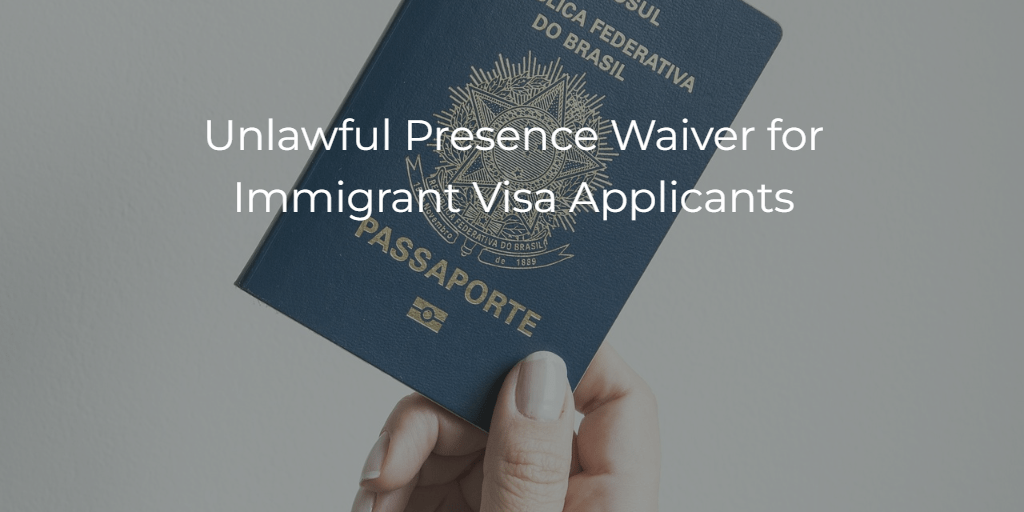
Unlawful Presence Waiver for Immigrant Visa Applicants
Individuals found to have been unlawfully present for more than 180 days, but less than one year, may be subject to a three-year bar from the United States. Those that are found to have been unlawfully present for more than 1 year, may be subject to a ten-year bar from the United States. If you are subject to these bars, and are applying for an immigrant visa you must secure a waiver of the unlawful presence inadmissibility in order to enter the US. Note, this article will focus on the immigrant visa (green card) waiver. The same waiver is not available for non-immigrant visas, and those subject to an unlawful presence bar seeking a non-immigrant visa, must consider a 212(d)(3) Hranka waiver. More details on the Hranka waiver for non-immigrant visas can be found: https://www.rnlawgroup.com/the-nonimmigrant-waiver/
For those applying for immigrant visas, historically, one could only apply for these waivers from outside of the US. However, in 2013, USCIS changed it and an individual can obtain a provisional waiver from inside the US. The I-601A waiver is used to file for a waiver of inadmissibility. Note, the I-601A should not be confused with the I-601 waiver. The I-601 waiver is used for other aspects of inadmissibility for green card applicants, the I-601A is specifically used for inadmissibility based on unlawful presence.
The unlawful presence waiver language can be found in the Immigration and Nationality Act, which states:
The Attorney General has sole discretion to waive clause (i) in the case of an immigrant who is the spouse or son or daughter of a United States citizen or of an alien lawfully admitted for permanent residence, if it is established to the satisfaction of the Attorney General that the refusal of admission to such immigrant alien would result in extreme hardship to the citizen or lawfully resident spouse or parent of such alien. No court shall have jurisdiction to review a decision or action by the Attorney General regarding a waiver under this clause.
. Through the INA language, regulations, and form instructions, there are multiple elements one must meet in order to qualify for an I-601A waiver:
- At least 17 years old;
- Physically present in the U.S. to file the form I-601A application and provide biometrics;
- Have a case pending with the Department of State based on:
- An approved immigrant visa petition (family or employment) that has the immigrant visa processing fee paid; OR
- Selected for the Diversity Visa Program
- Demonstrate that refusal of the admission will cause extreme hardship to their U.S. citizen or lawful permanent resident qualifying relative;
- Inadmissible only for unlawful presence in the United States
Many of the elements for an I-601A waiver are self-explanatory, but the qualifying relative and extreme hardship tend to be the most confusing. Note, you cannot apply for an I-601A waiver if you do not have a case pending with DOS, are actively in removal proceedings that are pending, or have a final order of removal or deportation.
For a relative to qualify as a qualifying relative for an I-601A waiver, the statute is very clear. The waiver may only be granted if the non-citizen’s spouse, son, or daughter is a US citizen or lawful permanent resident.
Notably, the hardship specifically requires “extreme” hardship, not just any hardship. This can be actual or prospective to the qualifying relative. There have been cases with the Board of Immigration Appeals finding that “simple” family separation or financial difficulties are insufficient by themselves to approve an I-601A waiver unless combined with something that has more impact. The evidence submitted for this must be thorough as this is the most likely area for USCIS to deny the waiver. Consider submitting things such as medical records, financial records, affidavits, etc. to establish hardship. USCIS has provided adjudicators with a list of some, but not all, factors and considerations of extreme hardship. That list, as of November 2022, can be found below:
|
Factors |
Considerations |
|
Family Ties and Impact |
· Qualifying relative’s ties to family members living in the United States, including age, status, and length of residence of any children. · Responsibility for the care of any family members in the United States, particularly children, elderly adults, and disabled adults. · The qualifying relative’s ties, including family ties, to the country of relocation, if any. · Nature of relationship between the applicant and the qualifying relative, including any facts about the particular relationship that would either aggravate or lessen the hardship resulting from separation. · Qualifying relative’s age. · Length of qualifying relative’s residence in the United States. · Length of qualifying relative’s prior residence in the country of relocation, if any. · Prior or current military service of qualifying relative. · Impact on the cognitive, social, or emotional well-being of a qualifying relative who is left to replace the applicant as caregiver for someone else, or impact on the qualifying relative (for example, child or parent) for whom such care is required. |
|
Social and Cultural Impact |
· Loss of access to the U.S. courts and the criminal justice system, including the loss of opportunity to request or provide testimony in criminal investigations or prosecutions; to participate in proceedings to enforce labor, employment, or civil rights laws; to participate in family law proceedings, victim’s compensation proceedings, or other civil proceedings; or to obtain court orders regarding protection, child support, maintenance, child custody, or visitation. · Fear of persecution or societal discrimination. · Prior grant of U nonimmigrant status. · Existence of laws and social practices in the country of relocation that would punish the qualifying relative because he or she has been in the United States or is perceived to have Western values. · Access or lack of access to social institutions and structures (official and unofficial) for support, guidance, or protection. · Social ostracism or stigma based on characteristics such as gender, gender identity, sexual orientation, religion, race, national origin, ethnicity, citizenship, age, political opinion, marital status, or disability. [6] · Qualifying relative’s community ties in the United States and in the country of relocation. · Extent to which the qualifying relative has integrated into U.S. culture, including language, skills, and acculturation. · Extent to which the qualifying relative would have difficulty integrating into the country of relocation, including understanding and adopting social norms and established customs, including gender roles and ethical or moral codes. · Difficulty and expense of travel/communication to maintain ties between qualifying relative and applicant, if the qualifying relative does not relocate. · Qualifying relative’s present inability to communicate in the language of the country of relocation, as well as the time and difficulty that learning that language would entail. · Availability and quality of educational opportunities for qualifying relative (and children, if any) in the country of relocation. · Availability and quality of job training, including technical or vocational opportunities, for qualifying relative (and children, if any) in the country of relocation. |
|
Economic Impact |
· Economic impact of applicant’s departure on the qualifying relative, including the applicant’s or qualifying relative’s ability to obtain employment in the country of relocation. · Economic impact resulting from the sale of a home, business, or other asset. · Economic impact resulting from the termination of a professional practice. · Decline in the standard of living, including due to significant unemployment, underemployment, or other lack of economic opportunity in the country of relocation. · Ability to recoup losses, or repay student loan debt. · Cost of extraordinary needs, such as special education or training for children. · Cost of care for family members, including children and elderly, sick, or disabled parents. |
|
Health Conditions |
· Health conditions and the availability and quality of any required medical treatment in the country to which the applicant would be returned, including length and cost of treatment. · Psychological impact on the qualifying relative due to either separation from the applicant or departure from the United States, including separation from other family members living in the United States. · Psychological impact on the qualifying relative due to the suffering of the applicant. · Prior trauma suffered by the qualifying relative that may aggravate the psychological impact of separation or relocation, including trauma evidenced by prior grants of asylum, refugee status, or other forms of humanitarian protection. |
|
Country Conditions |
· Conditions in the country of relocation, including civil unrest or generalized levels of violence, current U.S. military operations in the country, active U.S. economic sanctions against the country, ability of country to address significant crime, environmental catastrophes like flooding or earthquakes, and other socio-economic or political conditions that jeopardize safe repatriation or lead to reasonable fear of physical harm. · Temporary Protected Status (TPS) designation. · Danger Pay for U.S. government workers stationed in the country of nationality. · Withdrawal of Peace Corps from the country of nationality for security reasons. · DOS Travel Warnings or Alerts, whether or not they constitute a particularly significant factor, as set forth in Part E below. |
If you are subject to the inadmissibility for unlawful presence and are seeking either a Hranka waiver as a non-immigrant or an I-601A waiver for your immigrant visa application, you should consider the factors above and contact a qualified immigration attorney.
Reddy Neumann Brown PC has been serving the business community for over 20 years and is Houston’s largest immigration law firm focused solely on US. Employment-based immigration. We work with both employers and their employees, helping them navigate the immigration process quickly and cost-effectively.
Steven Brown is a Partner at Reddy Neumann Brown PC where he works in the Non-immigrant visa department and leads the Litigation Team. His practice covers all phases of the non-immigration visa process including filing H-1B, L-1, E-3, H-4, and H-4 EAD petitions. In the last two years, Steven has successfully handled over 1,000 non-immigrant visa petitions including filing petitions, responding to any necessary Requests for Evidence, and drafting motions and appeals. He has also become a key resource for F-1 students that seek guidance on properly complying with the F-1 visa regulations and any OPT or CPT issues they may have. Additionally, Steven holds a weekly conference call for companies that are part of one of the largest organizations for IT Services companies in America.

